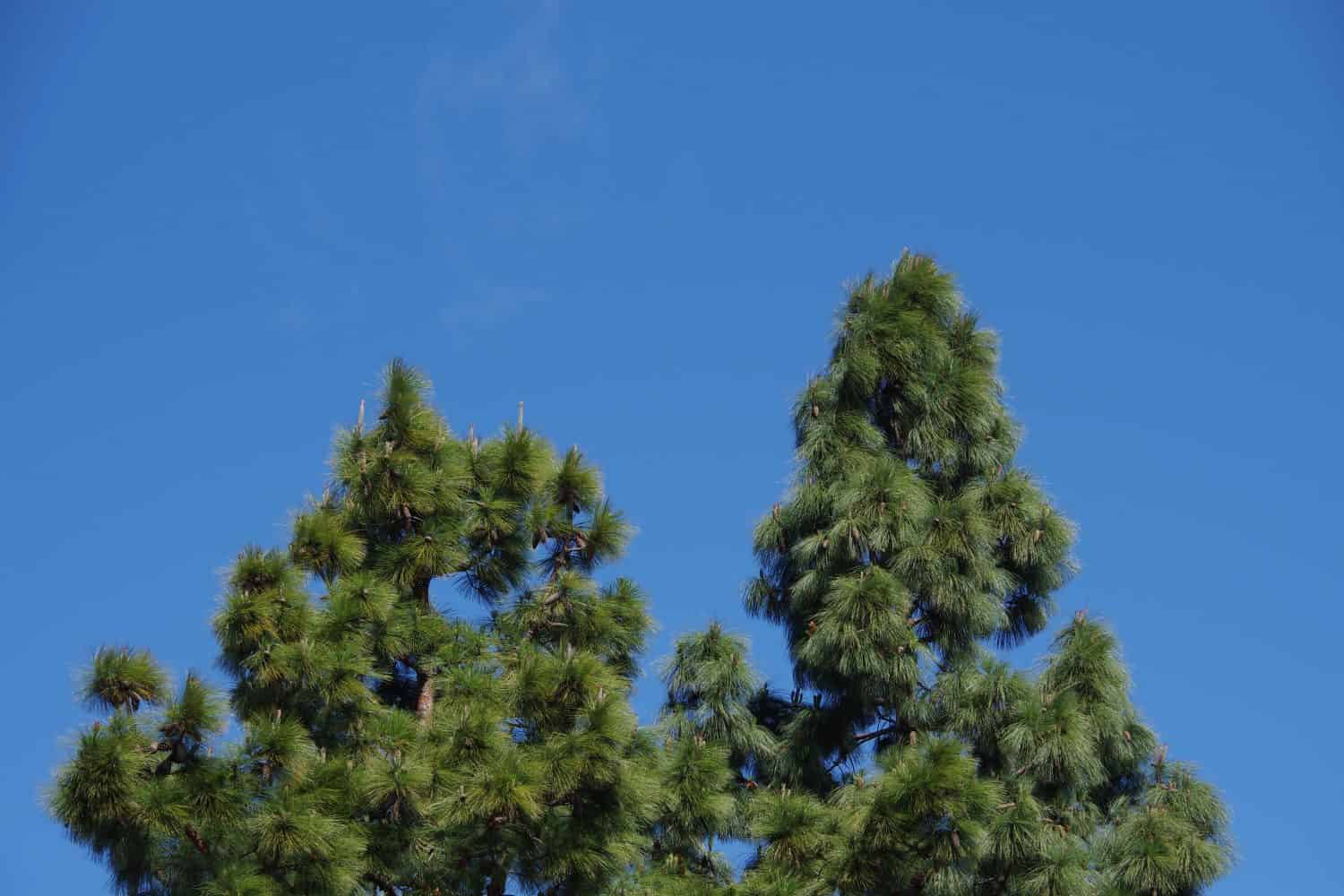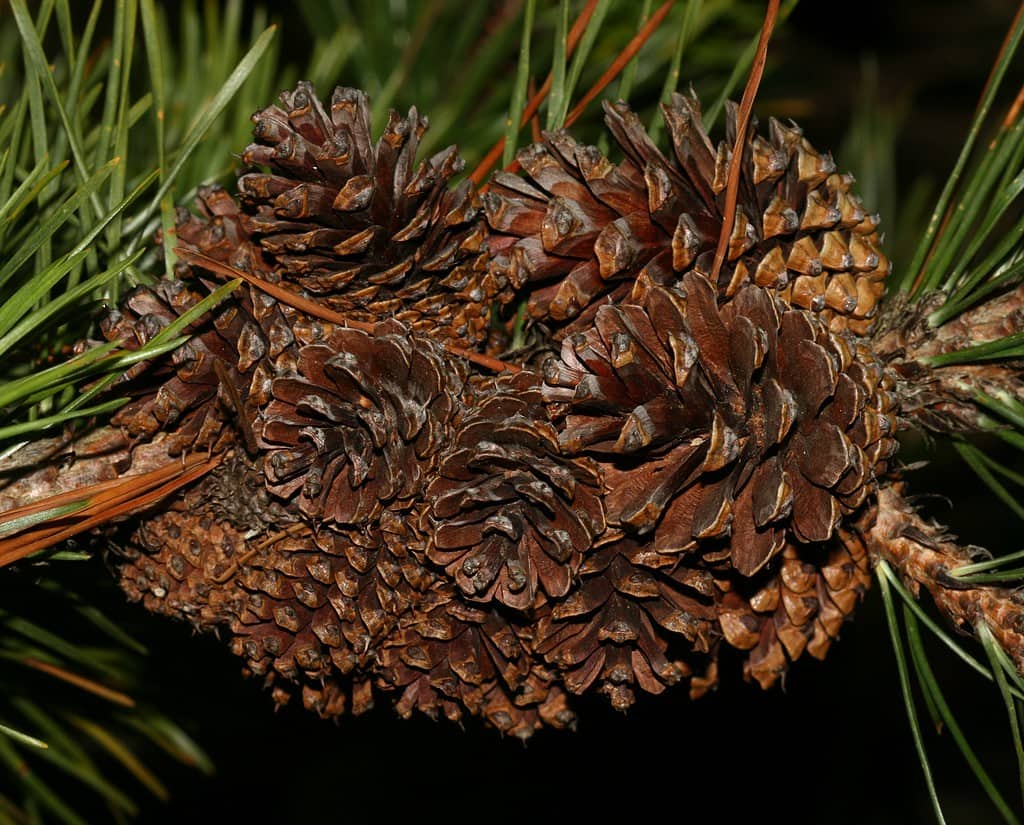California’s impressive forests are home to a great number of colossal trees including the craggy trunked Monterey Pine and Bishop Pine. Commonly referred to as ‘California closed-cone pines,’ these pines exhibit striking similarities in appearance and have shared ecological preferences, resulting in overlapping and extending ranges in the region. Consequently, distinguishing between the two species can be quite challenging. However, some key features like the overall tree form, bark patterns, and cone characteristics provide important clues to help differentiate between the two pine species. Here are six important differences that can aid in the identification of the two towering giants, the Monterey Pine and the Bishop Pine.
Comparing Monterey Pine and Bishop Pine
Before we delve into the main differences between the Monterey Pine and the Bishop Pine, here is a quick comparison of the two pine species.
| Monterey Pine | Bishop Pine | |
|---|---|---|
| Scientific Name | Pinus radiata | Pinus muricata |
| Other Common Names | Pino Quebradizo, Insignias Pine, Cambria Pine, radiate pine | Prickle-cone Pine, Pino Peninsular, Santa Cruz Island Pine, California swamp pine |
| Taxonomy | Kingdom: Plantae Phylum: Coniferophyta Class: Pinopsida Order: Pinales Family: Pinaceae Genus: Pinus | Kingdom: Plantae Phylum: Coniferophyta Class: Pinopsida Order: Pinales Family: Pinaceae Genus: Pinus |
| Size | 49.2 to196.9 feet tall | 49 to 50 feet tall |
| Form | Distinctive conical or pyramidal form, characterized by straight, symmetrical branches | Twisted form with irregular or open crown and spreading branches |
| Growth Rate | Fast | Moderate |
| Cone Shape and Color | Asymmetrically oval, grayish-brown cones | Exhibit a range of cone shapes, spanning in color from reddish-brown to faded gray |
| Needles | Five-inch needles arranged in clusters of three | Four to six-inch needles arranged in clusters of two |
| Bark | Red-brown to blackish-brown fissured bark | Deeply furrowed and scaly-plated bark |
| Hardiness Zone | 3-11 | 7-10 |
| Water Requirement | High | Medium |
| Sun | Thrives in full sun | Thrives in full sun but can tolerate partial shade |
| Soil | Thrives in a variety of soil types, preferably sandy or loamy soil | Prefers well-draining sandy and loamy soils |
| Geographic Range | Central coast of California, USA | Coastal areas of California and Oregon, USA. |
Key Differences Between the Monterey Pine and Bishop Pine
1. Geographic Range

Monterey Pines are recognized for their adaptability, thriving in sandy coastal soils and playing a crucial role in stabilizing sand dunes along the central California coast.
©Jack N. Mohr/Shutterstock.com
Monterey Pines are native to California and Baja California. This tree is planted abundantly throughout the world due to its sought-after qualities for lumber and pulp production. Paradoxically though, in its native range, the species is at risk of extinction. The natural range of Monterey Pine is now confined to three localities on the central California coast. The largest of these spans approximately 8,000 to 12,000 acres on and around the Monterey Peninsula. The second-largest is near the town of Cambria, covering about 2,500 acres. Another isolated stand, roughly 500 acres in size, is located at Pick Creek. Apart from this, their natural forests also exist in the islands of Guadalupe and Cedros off the coast of Baja California in the south.
Bishop Pine trees, on the other hand, are native to coastal areas of California and Oregon. It can also be found in the Santa Rosa islands, Santa Cruz as well as in Baja California, Mexico. Given the restricted range of the Bishop Pine and various threats jeopardizing its survival, this pine species has also been categorized as “vulnerable” on the Red List of the International Union for Conservation of Nature.
2. Cimatic and Edaphic Differences
There are notable climatic and edaphic differences between Monterey Pines and Bishop Pines. Monterey Pines flourish in a humid climate, showing adaptability to various soils, especially preferring loam to sandy textures. They thrive in acidic and well-draining conditions.
In contrast, the Bishop Pine thrives in a Mediterranean climate, excelling in dry and rocky soils. The adaptability of this pine tree extends to nutritionally poor soils, showcasing resilience even in challenging environmental conditions.
3. Differences in Tree Form

The Bishop Pine has a distinctive open crown, twisted and spreading branches, and long needles.
©Alina M Darkhovsky/Shutterstock.com
Monterey Pines typically have a compact, pyramidical form when they are young. As they mature, the canopy transforms into a more flat-topped or rounded structure. In the wild, they typically reach heights of 50 to 100 feet but can surpass 200 feet under optimal cultivation conditions, truly earning their status as towering giants.
On the other hand, Bishop Pines presents an asymmetrical or irregular form with stout, spreading branches and a conical, rounded, or irregular crown. Their mature height tends to be in the range of 40 to 60 feet, showcasing a different silhouette compared to the more structured growth of Monterey Pines.
4. Differences in Bark Patterns
Monterey Pines have barks that are deeply furrowed and range in color from reddish-brown to blackish-brown. The bark serves as a valuable resource for timber and various wood products, finding application in construction lumber, veneer, pulpwood for paper, and plywood.
On the other hand, the Bishop Pine features a dark gray bark with deep furrows forming long ridges and a scaly-plated texture. Its branches spread in an ascending pattern, often displaying contorted shapes. The shoots, initially orange-brown, evolve into a darker brown with a rough texture as they mature.
5. Differences in Needle Arrangement
The Monterey Pine has slender, glossy green needles arranged in clusters of three. These needles measure approximately five inches in length. In contrast, the Bishop Pine features dark yellow-green needles that are about four to six inches long. The needles are arranged in pairs, forming bunches of two. These needles of the Bishop Pine are typically shorter than those of the Monterey Pine.
6. Differences in Cone Characteristics

Monterey Pine cones are larger and more cylindrical, while Bishop Pines have smaller cones that often have an egg-shaped appearance.
©S. Rae from Scotland, UK / CC BY 2.0 – License
Another key difference between the stately Monterey Pine and the Bishop Pine lies in their cone characteristics. The male cones of the Monterey Pine are a brownish-orange color and look like little cylinders. They measure about half to two-thirds of an inch in length. Female cones, on the other hand, are ovate, meaning they have a roundish shape and are about 2 to 6 inches long. Initially lavender, the female cones transform to orangey-brown as they mature and eventually take on a grayish-brown hue with age. These cones may either stand-alone or occur in groups of three to five at the ends of the branches. Typically, it takes about two years for seeds to develop into mature cones after pollination.
The cones of the Bishop Pine are smaller in comparison to their giant relative the Monterey Pine. Measuring about three inches in length, the arrangement of the cones is, however, similar to that of the Monterey Pine. The cones of both the Bishop Pine and Monterey Pine are serotinous, remaining closed until triggered by high heat or fire.
The photo featured at the top of this post is © Jack N. Mohr/Shutterstock.com
Thank you for reading! Have some feedback for us? Contact the AZ Animals editorial team.







